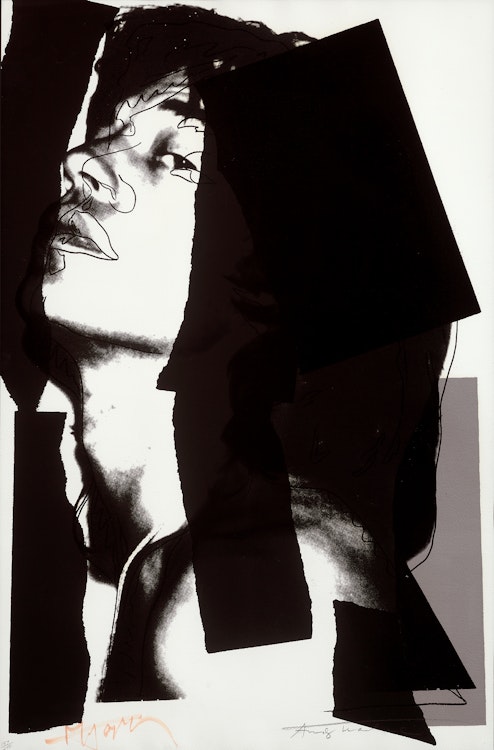Mick Jagger (F&S II.144) by Andy Warhol

Andy Warhol
Mick Jagger (F&S II.144)
screenprint on arches aquarelle (rough) paper
signed by the artist, numbered 157/250 and signed by Mick Jagger in the lower margin; printed by Alexander Heinrici, New York; published by Seabird Editions, London, England with their inkstamp on the reverse
43.5 x 29 in ( 110.5 x 73.7 cm ) ( sheet )
Auction Estimate: $140,000.00 - $180,000.00
Price Realized $180,000.00
Sale date: May 30th 2024
Private Collection, Toronto
Kynaston McShine, "Andy Warhol: A Retrospective", New York, 1988, pages 430 and 74
Frayda Feldman and Jörg Schellmann, "Andy Warhol Prints: A Catalogue Raisonné 1962-1987", 4th edition, Milan, 2003, catalogue no. II.144
Gregor Muir and Yilmaz Dziewior, "Andy Warhol", London, 2021, page 47
The process of creating these iconic portraits was a complex one. While the physical setting was nondescript, Warhol used a Polaroid Big-Shot camera, whose fixed depth of field forced him to experiment with distance, typically less than a metre away. The artist would have chatted away while giving various instructions to his subject. He would develop over a hundred Polaroids from these sessions but only keep four or five. He would alter the composition and contrast, the mouth and nose, balancing the proportions and retouching any visible blemishes. As Stephan Diederich, Curator at the Museum Ludwig in Cologne describes, Warhol's portraits: “clairvoyantly anticipate today’s increasing demands for constant self-publicising, with people capturing their every obsession, fleeting moment, revelation and deception, their image shaped by social media, but through his foresight, irony and empathy he also pointed the way to an approach that might work in response.”
Unlike the previous series with "Marilyn", 1967 (II.22–31) and "Mao", 1972 (11.90–99), where Warhol had to rely on stock photographs of his subjects, he instead took the pictures himself while the singer resided at his house in Montauk, in Long Island. He had, therefore, many examples to choose from. Mick gamely performed for the camera, appearing focused, defiant, laughing, or pensive. Based on these initial Polaroids, Warhol would portray the exuberant singer in ten poses for his portfolio.
Here, Mick is nonchalant and defiant: with an upturned chin, sidelong glance, and bare upper torso, a visually charged and intense image emerges. Thin drawing lines further draw the viewer’s attention to the subject’s main physical attributes, tracing the shape of his lush lips, arched neck, angular nose, and piercing gaze. For the 1989 retrospective exhibition held at the Museum of Modern Art, Mick would describe his participation in Warhol’s celebrity series as “a very painless exercise for me. It was fun staying up all night signing the lithographs.”
In 1975, Warhol developed a technique that would become the standard of his late style, using blocks of coloured graphic art paper with halftones and drawing lines. This collage-like effect would appear not only in the prints of "Mick Jagger" (II.138–147) but also in those of "Paloma Picasso" (II.121) and "Ladies and Gentlemen" (II.126–137). From Warhol’s Polaroid photograph, a drawing would be traced and chosen before being photographed, printed and made into a screen. Interestingly, the line would take on a dappled quality once printed on the Arches paper. Torn paper was also superimposed on the stylized linear drawing, mimicking the photographic image. For the "Mick Jagger" series, he would tear Color-Aid paper–an affordable medium used by graphic designers–before gluing the fragments onto the surface of a full-scale collage maquette, serving as a backdrop for a screened image, like in the present work.
The replicatory nature of Warhol’s oeuvre ultimately helped democratize the established hierarchy of art by immortalizing celebrities, commodities, deaths, and disasters alike through photography, painting and screenprinting. By erasing the so-called unapproachability of the rich and famous, the Pop iconoclast made his subjects more accessible than ever before to a broader audience.
Share this item with your friends
Andy Warhol
(1928 - 1987)
Fascinated by consumer culture, fame, and the media, Andy Warhol established himself as one of the most famous and influential artists of the twentieth century. Born in 1928 in Pittsburgh, Pennsylvania, to working-class immigrants from present-day Slovakia, Warhol grew up with an enduring interest in celebrities and mass culture. He studied at the Carnegie Institute of Technology before moving to New York City to become a successful commercial artist and illustrator. During the 1950s, his drawings were published in magazines and displayed in department stores. Yet, Warhol was developing his own style of painting at the same time, inspired by mass culture.
By the early 1960s, Warhol began producing paintings of banal consumer goods, such as soup cans and Coca-Cola bottles, and movie stars, thus establishing his status as the founder of Pop art. He deliberately blurred the lines between high and low art, celebrating popular culture and consumerism unlike ever before. Warhol embraced the photomechanical silkscreen process in 1962 by producing paintings through photography, thus rejecting traditional notions of the handmade and authorship from his works. The fact that his studio was called “The Factory” only reinforced this image. By 1963, he had replaced his silkscreen process for hand painting. Working with assistants, he produced series of flowers, cows, and portraits of celebrities like Marilyn Monroe, Queen Elizabeth II, Liz Taylor and Mick Jagger, among many others. In the early 1970s, he returned to painting after concentrating briefly on making films, producing monumental silkscreen images of Mao Zedong, commissioned portraits and the Hammer and Sickle series. A major retrospective of his work, organized by the Pasadena Art Museum in 1970, travelled across the United States and abroad. Warhol died in 1987 at the age of fifty-eight in New York.

